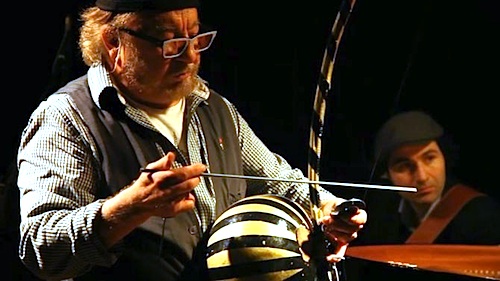By Joe Bendel. Arguably, Dave Brubeck’s second greatest hit is “Blue Rondo à la Turk.” It therefore ranks rather highly on the all time jazz hit parade, considering he also recorded the definitive version of Paul Desmond’s “Take Five.” Brubeck was serious about the “Turk” reference, crediting its genesis to his experience visiting Turkey and exploring the local rhythms. Inspiration would also flow back to Turkish jazz musicians from the American jazz masters. Batu Akyol surveys the history and music of the scene that developed in Jazz in Turkey, which screens during the 2014 San Francisco Global Movie Fest (in San Jose).
Viewers might expect it to be treated like a dirty secret, but pretty much everyone admits the pioneers of Turkish jazz were largely Armenians and Jewish Turks. After all, they were more receptive to western music and culture in general—and could maybe better identify with its blues roots. Of course, they were aware of the music’s African American heritage. In fact, one of the early popularizers of jazz in Turkey was an expatriate African American ensemble called Seven Palm Beach.
There will be more familiar names in Akyol’s documentary than casual viewers will expect, like Ahmet and Nesuhi Artegun, who discovered jazz when in America as the children of the Turkish Ambassador and would later become the leading independent producers in America through their label, Atlantic Records. Super-producer Arif Mardin also grew up as a jazz-loving teen in Turkey, before studying at Berklee (which proved to be the start of the school’s long association with Turkish students and faculty).
Essentially, Akyol identifies two primary approaches taken by Turkish jazz artists. Many follow western swing models, utilizing classical jazz instrumentations and arrangements. Erol Pekcan, whom Akyol identifies as the great statesman of Turkish jazz (he even worked as a translator for the U.S. embassy) largely fits in this camp—and man, that cat could play. On the other hand, fusions of jazz and traditional Turkish music also found an audience (particularly amongst tourists, not so ironically). Özdemir Erdoğan emerges as one of the early leaders of this movement—and man, could that cat play.

It hardly seems possible, but perhaps the history of Turkish jazz will not immediately intrigue broad-based mainstream audiences. However, the musical clips Akyol selects should seal the deal. They swing hard and are played with evident passion, yet many are still madly catchy. It would be cool to have a companion CD for this film, because nearly everything sounds great.
Indeed, that is the most important thing for any music doc. Akyol will definitely leave the audience wanting more Turkish jazz. Fans will also appreciate the occasional commentary from musicians like Herbie Hancock, Wayne Shorter, and Terence Blanchard. Those who enjoy hearing something new will find it very entertaining. Highly recommended, Jazz in Turkey screens this Friday (8/15) at the Towne3 Cinemas in San Jose, as part of the SF Global Movie Fest.
LFM GRADE: B+
Posted on August 13th, 2014 at 10:45am.